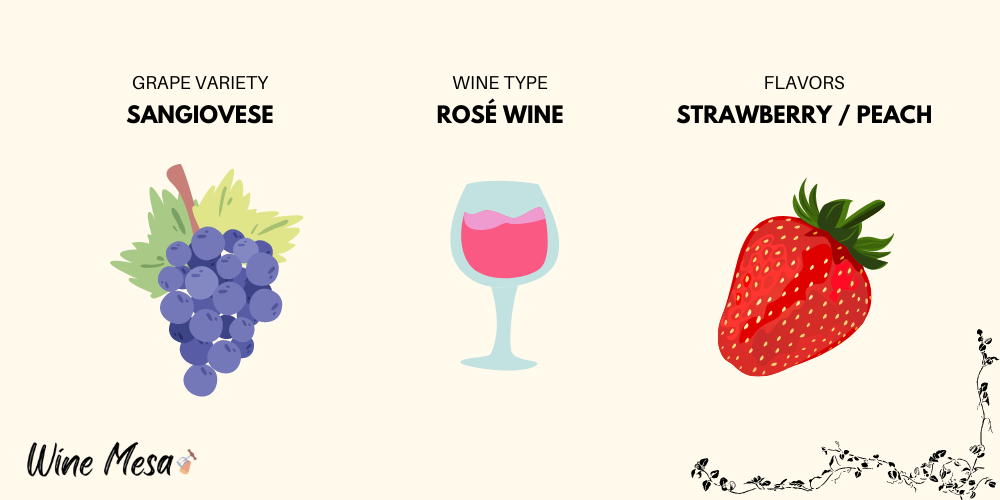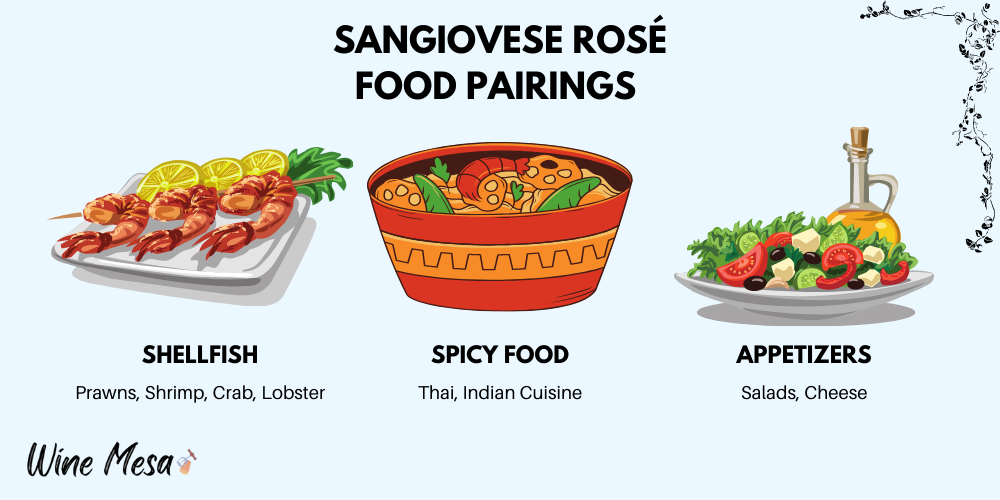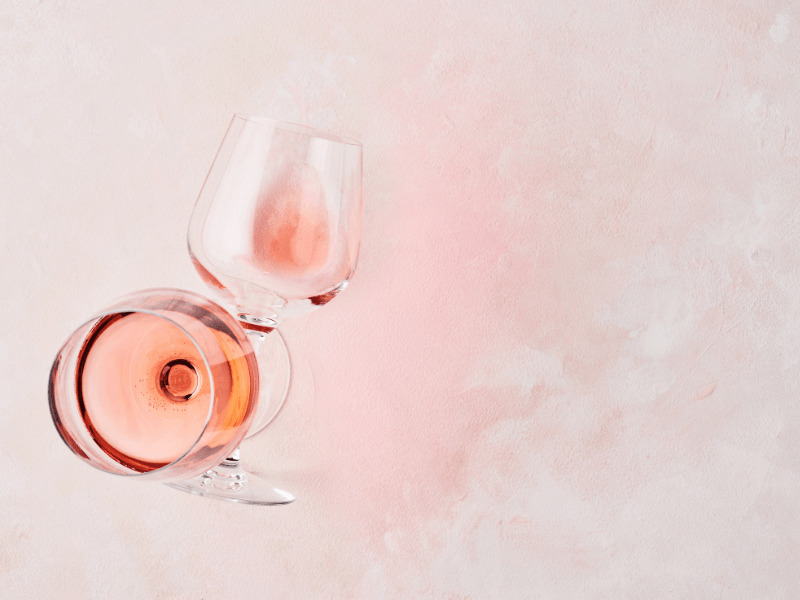Sangiovese is a type of red grape grown in Tuscany, Italy. The name translates to “sanguine wine” in Italian – it is named for the deep red colour that the grapes turn when ripe.
While some people may not know what Sangiovese wine tastes like, it is quite popular. It combines the flavours of fruit, spices, and earthiness.
Sangiovese Rosé wine is made from this type of grape as well! Here are some common questions about Sangiovese Rosé wine answered for you.

What Does Sangiovese Rosé Taste Like?
Sangiovese Rosé wine has a fairly sweet taste. It is low in acid and has a nice, fruity flavour. It is usually lighter than other types of rosé wine because the grapes are picked earlier, so they don’t get as much sun exposure.
The most common tasting notes found in Sangiovese rosé are strawberry, watermelon, peach, and a variety of citrus fruit. This wine is also commonly referred to as stony, earthy, and mineral.
Best Examples of Sangiovese Rosé
Ferrari Carano Dry Sangiovese Rosé – One of the most popular examples of this wine is Ferrari Carano Dry Sangiovese Rosé. This wine has all the flavour of a traditional Sangiovese but with a crisp and refreshing taste. It’s perfect for anyone who wants to enjoy a drink on a hot summer day. The Ferrari Carano Dry Sangiovese Rosé is dry, well-balanced, and fruit-forward.
Scotto Family Cellars Dry Sangiovese Rosé – Another great example of this wine is Scotto Family Cellars Dry Sangiovese Rosé. The Scotto Family Cellars Dry Sangiovese Rosé has light floral aromatics from its Chardonnay and Sauvignon Blanc blend. This wine pairs well with rice pasta and seafood dishes like lobster and crab cakes.
Yalumba’s Y Series Rosé – Whether you’re looking to sip something on the beach, at a pool party, or in your backyard, Yalumba’s Y Series Rosé is the perfect summer wine. This wine is full-bodied and fruity with strawberries, apricot, peach, and watermelon notes. It’s also high in alcohol, making it perfect for getting through those hot afternoons. You can buy Yalumba’s Y Series Rosé at your local store or online.
The LangeTwins Estate Grown Sangiovese Rosé – This is another example of this type of red grape. It’s distinguished by its extremely long legs or “legs”, as wines call them, giving it an almost rosy tint in colour. The LangeTwins Estate Grown Sangiovese Rosé is smooth and velvety with notes of raspberry and caramel that go down very easily.
Tini Sangiovese Rosé – The Tini Sangiovese Rosé also makes for a fantastic example as it runs at a lower price point than many other wines out there but still delivers great quality. The Tini Sangiovese Rosé drinks are fruity and lively, with notes of strawberry, apricot, peach, and fig leading to a long finish.
What Food Pairs with Sangiovese Rosé?
Sangiovese Rosé wine is a delicious by-product of Sangiovese grapes. It has a deep red colour and a sweet, fruity taste that pairs well with various foods. Some commonly suggested food to pair with Sangiovese Rosé wine are grilled or roasted pork or beef, mushrooms, and green vegetables.

If you want to get creative with your pairing, try cooking some pasta in bacon grease and adding it to the meat you’re cooking for dinner.
The gaminess from the bacon will contrast nicely with the sweetness from the wine. You can also find recipes online for different sauces for your pasta dish if you don’t have time to cook one yourself.
Is Sangiovese Rosé Sweet or Dry?
Sangiovese Rosé is dry, meaning it has no sugars. It is made from the dark red grape left on the vine to absorb more direct sunlight. This produces a less sweet, more fruity tasting wine.
Rosé wines are typically lighter in colour than red wines due to their exposure to less light during production. However, the Sangiovese Rosé wine’s colour is darker than many other Rosé wines because it is made by blending white and red grapes.
This dark colour can be attributed to its dark fruit flavours and earthy notes, which are all part of the terroir of the Tuscan region in Italy, where this type of grape is grown.
How is Sangiovese Rosé Made?
To make Sangiovese Rosé, you start by crushing the grapes and then press them into juice.
After that, the juice is fermented with yeast and sugar to create wine.
The wine is then aged in steel or oak barrels for 2-5 years before bottling.
Benefits of Drinking Sangiovese Rosé
Sangiovese Rosé contains many polyphenols, acids, and minerals that are good for your health!
Wine, in general, has been shown to have health benefits, but this type of wine is especially beneficial because it contains more antioxidant power than other types of wines.
It is also great for people who are sensitive to red wines because it does not contain as many tannins as many other wines.
Will Sangiovese Rosé Always Be Pink?
No – the colour of Sangiovese Rosé depends on how long it was aged. If you want a lighter coloured Sangiovese Rosé, then age the wine only 2-3 months after fermentation has completed.
For darker colours, age the wine 4-5 months after fermentation has completed.
Summary
Sangiovese Rosé wine is a great summertime wine because it is refreshing and light. Some of the best wines in this style are made in California, Australia, and Italy. These wines are typically dry and have a bright acidity while still maintaining the fruit-forward nature of the Sangiovese grape.
The wine pairs well with seafood and light dishes while not overpowering more robust dishes.
The best way to answer this question is to say that Sangiovese rosé is a blend of Sangiovese and Sauvignon Blanc grapes and is typically dry with a medium body. It’s also worth noting that the wine’s name comes from the grape it’s made from, Sangiovese.
Sangiovese is a grape that originates in Italy and has a history that traces back to the 13th century. It’s considered one of Italy’s noble grapes and is used in the production of Brunello di Montalcino, one of Italy’s most well-known wines.
Rosé wine gets its light colour because the grapes are only exposed to the skins for a very short time, so they retain very little colour.
Most people who order this wine will want it dry not to taste too sweet.
It’s important to note that many wines labelled as rosé are pink. While this may seem like a detail someone who isn’t an expert might not know, it’s worth mentioning because not all rosé wines are dry.
